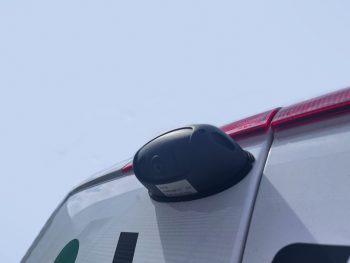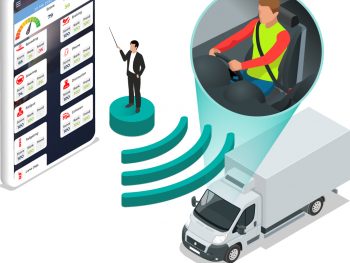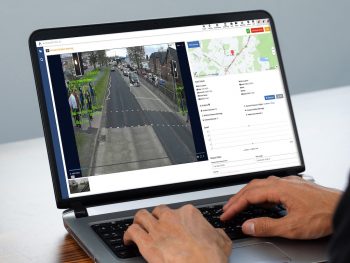Vehicle cameras can help to improve van security and support drivers as well as log activity in and around the vehicle. Matt MacConnell finds out more.

LCVs play a salient part in fleet-based businesses, travelling from site to site and transporting goods on Britain’s busy roads. In the event of an accident, claims can take a long time to file and can cause downtime. However, being able to show accurate video footage may accelerate a claim and insurance companies often provide discounts to those who have cameras installed too. While an accident can happen, there are also active crash scams that can be difficult to prove without a dashcam. According to insurance firm LV, personal injury claims relating to crash-for-cash incidents in Scotland increased by 60% between 2021 and 2022 – staged incidents that can prove costly for fleets.
Dashcam technology has advanced in recent years and video quality no longer resembles that of a Nokia 7650, with a lot of camera systems now offering 4k resolution. Various systems also deliver GPS integration which feeds information back to fleet managers, ensuring drivers stick to their predetermined routes.
Unlike older systems, cameras no longer require data to be extracted from an SD card – a way that could prove unreliable as the card could be misplaced or damaged. Instead, modern cameras can send information about a driver’s journey: how heavy-footed they have been or how frugal, if any sharp braking or turns have been recorded, engine diagnostics and more, alerting the fleet manager or administration staff via a notification. In many instances, software even allows for staff to view a live feed of the driver’s journey, which can be helpful for drivers who are lost and need directions from the back office.

Cameramatics offers an all-in-one fleet management system; Mervyn O’Callaghan, CEO, says: “I think what we do well is pull all that information into a meaningful score and summary, so someone can analyse which drivers need to be spoken to and which drivers are performing well. Our system has been built around the premise of engaging more with the driver, rather than the company, so it’s about empowering the driver.”
Cameramatics’ new I-Coach module also sends video clips to the driver to review with comments, the driver will then be sent training material that’s linked to the specific driving behaviour.
Vans that carry loads, act as a recovery service or store equipment can also have security camera systems mounted to the rear of the cab or inside the load space. The footage can then be sent live to the driver via an in-cab monitor and can be recorded. This not only allows the driver to keep watch over a secure load but can also prove valuable in the event of a break-in.
In recent years, companies have developed further by integrating artificial intelligence into their new camera systems and it is becoming increasingly popular – but what does this mean for fleets? There are various levels of AI available from companies such as Inseego, Cameramatics, VisionTrack and Radius, through which cameras can detect environments and any harsh movement will be recorded as an event and fed back to the fleet manager automatically, via a cloud-based user interface.

However, for larger fleets this may be troublesome. If every van in a fleet hits a pothole large enough to set off the detection system, the fleet manager will be flooded with events which will take some time to dig through. Intelligent systems, such as VisionTrack’s NARA, can automatically go through recordings to rule out any false alarms, giving the fleet manager only relevant footage. Companies will also offer different packages when it comes to cloud storage and how long footage can be saved before having to upgrade.
Cameramatics has recently built video analysis that can be used through either an Android or Apple mobile phone. The phone will be mounted in a cradle and will use its own camera to record video, acting similarly to a dashcam. Before the driver sets off on their journey, the phone has to be put into a ‘drive mode’ which turns off features such as messaging but still allows for hands-free services.
There are AI cameras that also record the driver – if the camera recognises that the driver is distracted or fatigued, it will feed the information back to them in real-time to help prevent an accident.
Of course, this can also raise a concern in drivers that they are under surveillance and may feel untrusted. Inseego managing director Steve Thomas says: “Most drivers, we find, are fine with a forward-facing dash camera. People have privacy issues when it comes to having a camera on them but it’s all about using the system properly. We offer a lens-as-a-sensor solution which still points at the driver and will detect risky driving, beeping at the driver whenever they are distracted. Of course, the camera can be turned on if required or left as a sensor. Our camera systems can be configured in different ways to suit the fleet manager.”
The Information Commissioner’s Office claims: “You can use a camera in your business vehicle, as long as you can justify it. You need to tell people you’re recording them, handle the footage responsibly and check your data protection fee payments are up to date. You should also be aware of people’s rights because you have a role to play in protecting them.” Camera audio can be found intrusive but in most camera systems this can be turned off. If an employee complains to the ICO, the company in question could face a fine.
Companies that are looking at hardwired dashcam installations can approach organisations such as Inseego which will guide them through the process. Inseego will also offer trials to customers that are interested in exploring the technology. If they then wish to go ahead with a system, an arrangement can be made for the work to be done at the customer’s location rather than having to visit a branch.
Radius managing director Greville Coe shares: “Vulnerable road-users accounted for 50% of fatalities. This is compared to car occupants which accounted for 44% of road users killed in Great Britain.”
Manufacturers nowadays often equip their vans with a plethora of safety tech as standard, or this is available as an optional extra. Intelligent blind spot warning and intervention systems help detect objects in a van’s blind spot, applying slight braking force when required to keep the van in its lane. Intelligent forward collision warning and emergency braking systems give audible warnings when a vehicle in front has slowed and will automatically apply the brakes, if required, to help avoid accidents. Intelligent cruise control helps keep the distance between the van and other road users by automatically slowing the van. Finally, 360° cameras give the van driver an all-round view.
VisionTrack offers a vulnerable road user (VRU) AI-powered camera for those fleets that don’t have a 360-camera system. The camera will detect pedestrians, cyclists, motorcyclists and scooter riders around a van’s blind spot and will alert the driver – a worthy solution for fleets that are often in busy town centres or congested areas. An audible system can also be installed on the exterior of the vehicle to alert pedestrians that the vehicle is making a turn. Radius’ subsidiary company, Vue, is also trialling a pedestrian AI camera system.

